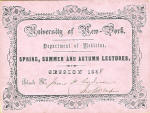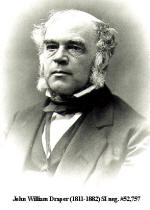John William Draper, M.D.
(1811-1882)

Click image to enlarge
Go to lecture card display
 John Draper, the subject of
this sketch was born at St. Helen's, near Liverpool, England, on the 5th
of May, 1811. His earliest education was obtained at a Wesleyan
Methodist school, but after a time he came under private teachers, with
whose help he made rapid progress in the physical sciences, thus showing
in his boyhood the natural bent of his mind and the real strength of his
intellect. He afterwards studied for a time at the University of London,
but in 1833 came to the United States, and three years later graduated
at the University of Pennsylvania with the degree of M. D. In 1839 he
was elected to the chair of chemistry in the University of New York, a
position which he held until his death in 1882. John Draper, the subject of
this sketch was born at St. Helen's, near Liverpool, England, on the 5th
of May, 1811. His earliest education was obtained at a Wesleyan
Methodist school, but after a time he came under private teachers, with
whose help he made rapid progress in the physical sciences, thus showing
in his boyhood the natural bent of his mind and the real strength of his
intellect. He afterwards studied for a time at the University of London,
but in 1833 came to the United States, and three years later graduated
at the University of Pennsylvania with the degree of M. D. In 1839 he
was elected to the chair of chemistry in the University of New York, a
position which he held until his death in 1882.
Draper's contributions to science were of a high order. He discovered
some of the facts that lie at the basis of spectrum analysis; he was one
of the first successful experimenters in the art of photography; and he
made researches in radiant energy and other scientific phenomena. He
published in 1858 a treatise on 'Human Physiology,'
which is a highly esteemed and widely used text-book. He died on the 4th
of January, 1882.
Draper's chief contributions to literature are three works: ' History of
the Intellectual Development of Europe' (1863), a 'History of the
American Civil War' (1867-1870), and 'The History of the Conflict
between Religion and Science,' which appeared in the International
Scientific Series in 1873. Of these works, the one on the intellectual
development of Europe is the ablest, and takes a place beside the works
of Lecky and Buckle as a contribution to the history of civilization.
The history of the Civil War was written too soon after the events
described to have permanent historical value. ' The History of the
Conflict between Religion and Science' is a judicial presentation of the
perennial controversy from the standpoint of the scientist.
Draper's claims to attention as a philosophic historian rest mainly on
his theory of the influence of climate on human character and
development. He maintains that "For every climate, and indeed for every
geographical locality, there is an answering type of humanity": and in
his history of the American Civil War, as well as in his work on the
intellectual development of Europe, he endeavored to prove that
doctrine. Another theory which is prominent in his principal work is,
that the intellectual development of every people passes through five
stages; namely, i, the Age of Credulity; 2, the Age of Inquiry; 3, the
Age of Faith; 4, the Age of Reason; 5, the Age of Decrepitude. Ancient
Greece, he thinks, passed through all those stages, the age of reason
beginning with the advent of physical science. Europe as a whole has now
also entered the age of reason, which as before he identifies with the
age of physical science; so that everywhere in his historical works,
physical influences and the scientific knowledge of physical phenomena
are credited with most of the progress that mankind has made. Draper has
left a distinct mark upon the scientific thought of his generation, and
made a distinct and valuable contribution to the literature of his
adopted country.
|